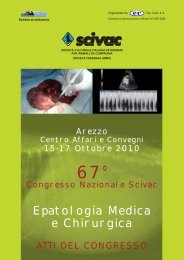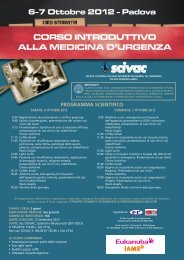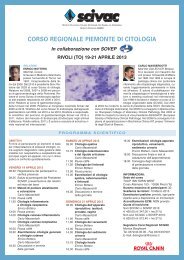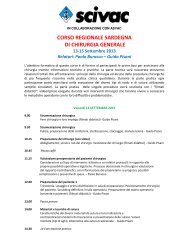68° Congresso Nazionale SCIVAC: Le domande più frequenti in ...
68° Congresso Nazionale SCIVAC: Le domande più frequenti in ...
68° Congresso Nazionale SCIVAC: Le domande più frequenti in ...
You also want an ePaper? Increase the reach of your titles
YUMPU automatically turns print PDFs into web optimized ePapers that Google loves.
<strong>68°</strong> CONGRESSO NAZIONALE <strong>SCIVAC</strong> 11-13 Marzo 2011 - Milano<br />
LE DOMANDE PIÙ FREQUENTI IN RIPRODUZIONE CANINA E FELINA<br />
Tutto quello che i vostri clienti osano spesso chiedere e a cui voi non sapete rispondere<br />
14 th EVSSAR Congress - Advances <strong>in</strong> Fel<strong>in</strong>e Reproduction - March 11 th 2011<br />
mg/kg of oestradiol benzoate, 3, 5 and 7 days after mismat<strong>in</strong>g. The efficacy<br />
is around 95% (Sutton et al. 1997).<br />
A more recent publication recommends one s<strong>in</strong>gle <strong>in</strong>jection of 0.2 mg/kg<br />
2 days after mat<strong>in</strong>g (Tsutsui et al. 2006). Accord<strong>in</strong>g to these authors, the efficacy<br />
seems unchanged.<br />
Side effects: the best know secondary effect concerns the risk of <strong>in</strong>duced<br />
CEH-pyometra. Accord<strong>in</strong>g to most authors, pyometra after a pregnancy term<strong>in</strong>ation<br />
treatment us<strong>in</strong>g oestrogens may develop <strong>in</strong> 7.3 to 15% of the cases<br />
(Sutton et al. 1997, Eilts 2002).<br />
Only aglepristone may be a safe and effective drug to medically term<strong>in</strong>ate<br />
pregnancy at this early stage.<br />
We strongly recommend veter<strong>in</strong>arians first to perform a vag<strong>in</strong>al smear: it<br />
allows veter<strong>in</strong>arians to know if the bitch is still <strong>in</strong> oestrus or if the bitch has<br />
reached the dioestrus stage.<br />
A recent meet<strong>in</strong>g of specialists (<strong>Le</strong>nnoz 2006) recommended veter<strong>in</strong>arians<br />
wait<strong>in</strong>g until the beg<strong>in</strong>n<strong>in</strong>g of dioestrus to beg<strong>in</strong> an abortive medical protocol<br />
with antiprogest<strong>in</strong>s.<br />
This is due to the average 6 days residence time of aglepristone <strong>in</strong> the body<br />
after subcutaneous adm<strong>in</strong>istration. If a bitch is mated a little bit before<br />
ovulation, when the progesterone plasma level is still low, and if she is treated<br />
at once with aglepristone - which acts <strong>in</strong> under one week - it cannot be excluded<br />
that she may still become pregnant, due to the long survival of sperm<br />
<strong>in</strong> the genital tract.<br />
2.2.2. The bitch is brought to consultation <strong>in</strong> early<br />
pregnancy (before day 15 to 21 after mat<strong>in</strong>g, when a<br />
pregnancy diagnosis is still impossible to make)<br />
The advisability of medical treatment to term<strong>in</strong>ate pregnancy at an early<br />
stage is always open to discussion. Several studies have shown that many bitches<br />
brought to veter<strong>in</strong>ary consultation at this early stage are <strong>in</strong> fact not pregnant.<br />
From our personal po<strong>in</strong>t of view, due to the relatively lower efficacy of<br />
pregnancy term<strong>in</strong>ation at mid-term pregnancy (see paragraph 3.3), due to<br />
ethical aspects (no live fetuses are visualized by bitch owners) and due the potential<br />
development of side effects when an abortion is <strong>in</strong>duced later <strong>in</strong> pregnancy,<br />
we would rather recommend an early pregnancy term<strong>in</strong>ation when<br />
owners can afford it f<strong>in</strong>ancially.<br />
47

















